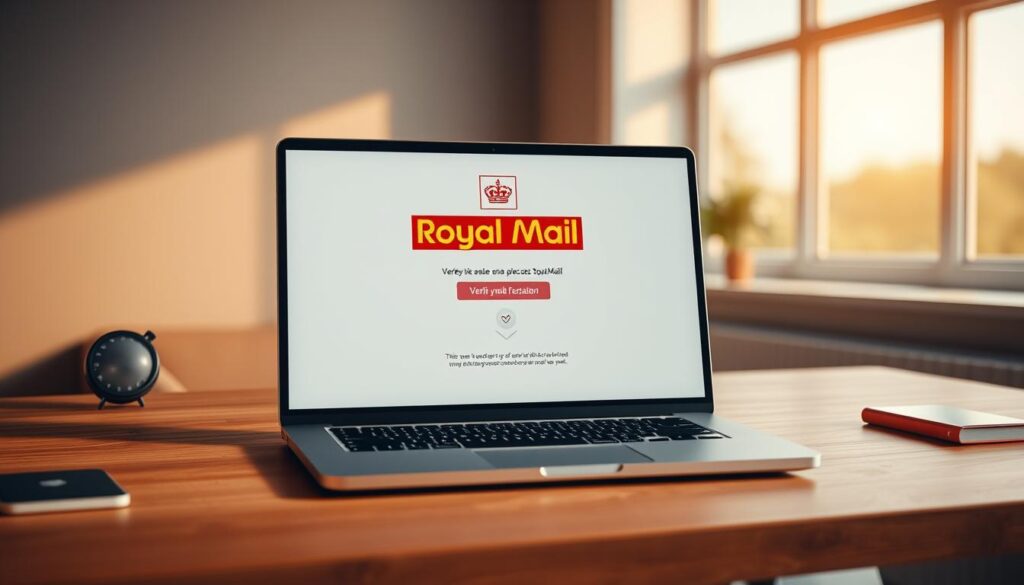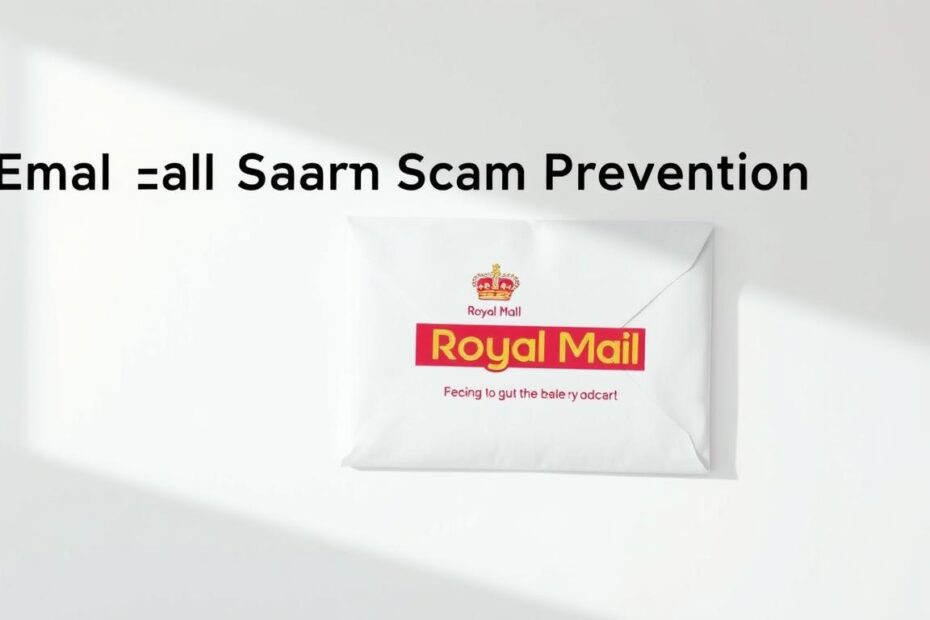Ever wonder how scammers make fake Royal Mail emails seem real? Phishing scams are getting smarter, making it key to know how to avoid them.
Royal Mail gets many reports of fake emails trying to steal your info. Scammers use tricks to look real, risking your money and personal data. Knowing a real Royal Mail email can keep you safe from big problems.
This guide will teach you to spot and dodge fake emails. You’ll learn to tell real Royal Mail emails from fake ones. This way, you can stay safe from scams.
Key Takeaways
- Always verify the sender’s email address carefully
- Never click on suspicious links in unexpected emails
- Royal Mail will never request sensitive personal information via email
- Check official Royal Mail websites for communication verification
- Use email filtering and anti-phishing tools for protection
Understanding Phishing Scams
Digital threats are everywhere. Phishing scams are a big risk for email users. They try to trick you into giving out personal info or installing bad software. Knowing how to spot real Royal Mail emails can keep you safe.
Phishing is a sneaky way to trick people. Scammers pretend to be trusted groups. They want to get you to give up your personal info or mess with your computer.
What Exactly Is Phishing?
Phishing is when bad guys send fake messages that look real. To spot fake Royal Mail emails, look for these signs:
- Urgent or threatening language
- Requests for immediate action
- Generic or impersonal greetings
- Suspicious email addresses
- Unexpected attachments or links
How Phishing Operates
Cybercriminals are smart. They make their emails look real. They do things like:
- Mimic official branding
- Create sense of urgency
- Exploit current events or trends
- Use psychological manipulation
Common Characteristics of Phishing Emails
To spot scam emails, know what they look like. Real organizations like Royal Mail won’t ask for personal info by email. Look out for spelling mistakes, odd requests, and links that don’t match the sender’s domain.
Identifying Legitimate Royal Mail Emails
It’s important to be careful with Royal Mail emails. You need to know how to tell real emails from fake ones. This helps keep your personal info safe.
Cybercriminals try to trick you with fake emails. Knowing how to spot these can protect you from harm.
Checking the Sender’s Email Address
Real Royal Mail emails have certain signs. Here’s what to look for:
- Official Royal Mail emails always come from @royalmail.com domains
- Avoid trusting emails from public domains like Gmail, Hotmail, or Yahoo
- Check for subtle misspellings or unusual character replacements
Recognizing Official Royal Mail Domains
Knowing the real Royal Mail email domains is key. Here’s what to expect:
- Always from verified @royalmail.com email addresses
- They have consistent branding and look professional
- Never ask for your personal info via email
Learning these tips can help you avoid scams. Always be careful and listen to your gut when you see something odd.
Analyzing Email Content
To spot Royal Mail email fraud, you need to look closely at the email’s content. Scammers try to make their fake emails look real. They want you to think they are from Royal Mail.
Signs of Fraudulent Language
Phishing emails have certain signs that show they are fake. Knowing these signs can help keep you safe from scams.
- Poor grammar and spelling mistakes
- Overly dramatic or urgent language
- Inconsistent formatting
- Unprofessional tone
Unusual Requests for Personal Information
Real Royal Mail emails never ask for your personal info. Be very careful of emails that ask for:
- Social security numbers
- Bank account information
- Credit card details
- Login credentials
Scammers try to rush you to act fast. They might say your package is in danger or you’ll face trouble if you don’t act quickly.
| Fraudulent Email Characteristics | Legitimate Communication Indicators |
|---|---|
| Generic greeting | Personalized address |
| Suspicious sender email | Official Royal Mail domain |
| Urgent language | Professional, calm tone |
| Request for personal info | No sensitive data requests |
Remember, staying vigilant is your best defense against email fraud.
Verifying Links in Emails
Email links can be dangerous traps for unsuspecting users. When performing royal mail email security checks, it’s key to know how to check links. This helps protect your personal info.

Phishing scammers often hide bad links to trick you. To keep your info safe, learn how to check links in emails.
Safely Examining Email Links
Before clicking any link, you can protect yourself using these strategies:
- Hover your mouse over the link to reveal its true destination
- Check if the URL matches the official Royal Mail domain
- Look for suspicious misspellings or unusual character replacements
- Verify the link’s root domain carefully
Understanding URL Shortener Risks
URL shorteners can hide a link’s true destination. This makes them a security risk. If you see shortened links in emails from Royal Mail, be extra careful:
- Use online link expansion tools to preview the full URL
- Avoid clicking directly on shortened links
- Cross-reference the expanded link with official Royal Mail websites
Pro tip: Legitimate Royal Mail communications will typically use their official domain without link shorteners.
Always put your digital safety first. Do thorough royal mail email security checks before dealing with any suspicious links.
Checking for Authentic Royal Mail Communications
It’s important to check if Royal Mail emails are real. This helps avoid scams and keeps your money safe.
To make sure Royal Mail emails are real, follow some key steps. Royal Mail has many ways to help you check messages.
Direct Contact Methods
If an email looks fishy, you can take action:
- Call Royal Mail’s official customer service number
- Visit their official website at royalmail.com
- Use their official customer support email
- Check tracking information through official channels
Website Cross-Referencing
The Royal Mail website has tools to check emails:
- Check recent communication logs
- Verify delivery notifications
- Review current scam alerts
- Compare received email details with official records
Remember, Royal Mail will never ask for money via email. They also won’t send links for payments. They use grey cards for extra fees.
By using these steps, you can stay safe from scams. You’ll keep your personal info safe from fraudsters.
The Importance of Email Security
Keeping your email safe is very important today. This is true when you get emails from places like Royal Mail. It’s not just about having a strong password. It’s about keeping all your personal info safe and stopping bad guys from tricking you.
Royal Mail needs you to be very careful with your email. Bad people are always finding new ways to get into your email. You need to use strong ways to keep your emails safe.
Keeping Your Email Account Secure
Here are some key steps to make your email safer:
- Create complex passwords with a mix of uppercase, lowercase, numbers, and symbols
- Update passwords every 3-4 months
- Avoid using personal information in passwords
- Never share login credentials with anyone
Leveraging Two-Factor Authentication
Two-factor authentication adds extra protection. It makes you do two things to get into your account:
- Enter your password
- Provide a second verification method (like a code sent to your phone)
Using these methods makes it much harder for bad people to get into your email. This helps stop phishing attacks.
Pro tip: Always keep your operating system and antivirus software updated to protect against the latest digital threats.
Reporting Suspicious Emails
Seeing royal mail scam emails can be scary. But, knowing how to report them is key to keeping safe. Quick action stops more scams from happening.
Here’s what to do if you find a suspicious email:
Reporting to Royal Mail
- Send the email to reportascam@royalmail.com
- Send the whole email header and content
- Don’t click on links or open attachments
- Wipe out the scam email after you report it
Reporting to Authorities
To really protect yourself, report to the right places:
- Go to actionfraud.police.uk online
- Call Action Fraud at 0300 123 2040
- Tell them about the scam email
- Save all your messages
Your quick action helps stop scams. It helps police catch scammers who target many people.
Using Technology to Your Advantage
Protecting yourself from Royal Mail phishing needs smart tech. Digital tools boost your ability to find email scams early. This helps prevent big problems.

Today’s email security is strong against phishing. These tools check messages fast and find threats well.
Email Filtering Tools
Email filters cut down scam risks a lot. They work quietly to keep your emails safe.
- Automatic threat detection algorithms
- Real-time email scanning
- Suspicious link identification
- Sender verification mechanisms
Anti-Phishing Software Options
Picking the best anti-phishing software is key. Here are some top choices:
| Software | Key Features | Effectiveness Rating |
|---|---|---|
| Microsoft Defender for Office 365 | Advanced threat protection | 9/10 |
| Mimecast Email Security | Comprehensive spam filtering | 8.5/10 |
| Proofpoint Email Protection | Machine learning detection | 8/10 |
When picking software, think about what you need. Choose tools with updates and wide threat detection. Keeping up with new scams is key.
Don’t think one tool can stop all scams. Mix tech with being careful for the best defense.
Staying Informed About New Scams
Protecting yourself from phishing is key. Royal Mail scammers keep coming up with new tricks. Knowing the latest scams can help you stay safe.
Check if emails are from Royal Mail by using their official sites. Their website and social media have updates on scams. You can also get email alerts about new phishing tricks.
Online groups and forums share info on Royal Mail scams. People share tips and warning signs. Joining these groups helps you learn about new threats fast.
Technology and knowing what’s out there are your best friends. Keep your security up to date and be careful with emails. Learning about scams helps keep your info safe.
